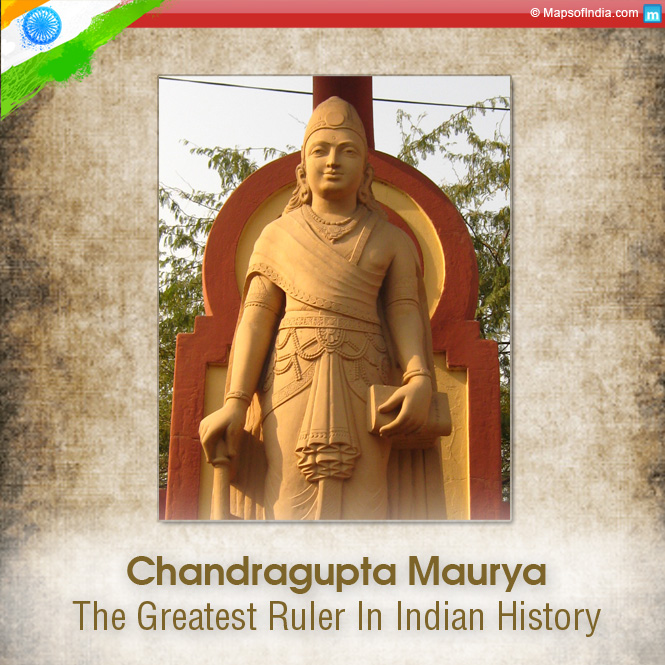India unified as a single entity for the first time under the rule of the great emperor Chandragupta Maurya (340 BC – 298 BC). Before his rule most of the south Asia was divided into small states whereas Gangetic Plains were ruled by the Nanda Dynasty. Chandragupta Maurya by conquering most of the Indian subcontinent gave political unity to India and laid the foundation of Mauryan Empire.
Though very less information about Chandragupta Maurya’s early days is available but it is assumed that he was born around 340 BCE to a mother named Mura. It is also believed that word Maurya came from his mother’s name. He ruled for 24 years as described in Puranas (historical Sanskrit work). He was then succeeded by his son Bindusara who ruled for 25 years. Bindusara was then succeeded by Asoka in 274 B.C.
Information about his ancestry is also ambiguous. As per most of the Indian literary traditions, Chandragupta Maurya was connected with the Nanda Dynasty. After about a half millennium, he was called as “Nandanvaya”, i.e. the descendant of Nanda (Act IV) in the Sanskrit drama Mudrarakshasa. As per Vishnu Purana’s medieval commentator, Chandragupta Maurya was born to Nanda prince and his maid Mura. Whereas Buddhist text, the Mahavamsa, says that Chandragupta Maurya is from Moriya, a branch of the Khattiya (Kshatriya) clan. Facts are difficult to separate from fiction.
Different lessons of politics and war were taught to Chandragupta by Chanakya. Chanakya or Kautilya was a great scholar, teacher of economics and political science at ancient Takshashila University. Chanakya then became the mentor of Chandragupta Maurya. By defeating Dhana Nanda of Nanda, Chandragupta Maurya established Maurya Empire.
His was the largest empire in the Indian history. In east the Maurya Empire extended from Bengal and Assam to Afghanistan and Balochistan, in west was eastern and south-east Iran, to Kashmir in the north, and to the Deccan Plateau in the south. He was just 20 years old at the time when he founded the empire.
Chandragupta Maurya was the first one to face the result of a foreign invasion and the state of depression. He set the nation free from the Greek rule.
Chandragupta Maurya conquered Alexander the great and his successor Seleucus I Nicator. Then Chandragupta Maurya married to the daughter of Seleucus to set up a policy of friendship with the Hellenistic kingdoms. This had really pushed up the India’s trade with the western world.
After the unification of India, important social and political reforms were carried out by Chandragupta Maurya under the advice of Chanakya. A strong central administration was established with extremely ordered bureaucratic structure. Because of such a strong administration both trade and agriculture were thrived and made the economy very strong. Art and architecture flourished to a great extent during Mauryan Empire. Buddhism and Jainism became important religion.
In Greek and Latin Chandragupta is also known by the names of “Sandracottos” or “Andracottus. Maurya Empire existed for about 137 years. He took a voluntary retirement and handed over his throne to his son Bindusara in 298 BC. He was just 42 years old at that time.
It is believed that Chandragupta Maurya adopted Jainism and became an ascetic under the Jain saint Bhadrabahu. He ended his days at Śravaṇa Beḷgoḷa (in present day Karnataka) by sallekhana (death by fasting).
Chandragupta Maurya is the most influential ruler along with his grandson Ashoka. Unification of India under their rule established the foundation of modern day India.
Related Information :
Development of Art During the Mauryan Empire
The Birth of River Valley Civilisations in India





